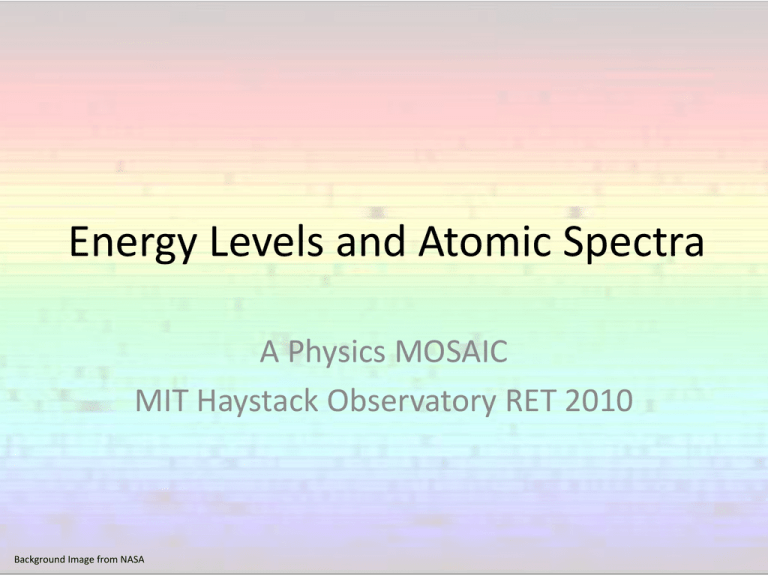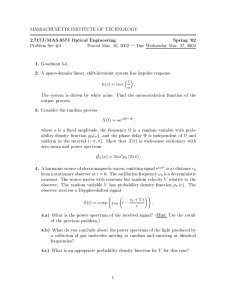Energy Levels and Atomic Spectra A Physics MOSAIC Background Image from NASA
advertisement

Energy Levels and Atomic Spectra A Physics MOSAIC MIT Haystack Observatory RET 2010 Background Image from NASA Observed Phenomena Found on Wikipedia, User Jeff Kubina, Creative Commons Image from NASA.gov Blackbody Radiation • A blackbody is a hypothetical object that is a perfect emitter of all light and electromagnetic radiation. • The observed phenomena on the previous slide are difficult to explain with classical physics. The failure of the classical models to explain observed behavior was called the ultraviolet catastrophe. • A couple of (quantitative) relationships observed in blackbody radiation – I (total intensity) proportion to T4 – lmax (wavelength of peak intensity) proportional to 1/T From webExhibits, www.webexhibits.org/causesofcolor. Creative Commons Quantization of Energy • The solution to the UV catastrophe was the assertion (by Planck) that EM radiation comes only in discrete packets of energy (called photons), and the energy of these packets is proportional to the frequency of the EM radiation. • This quantization was further verified by Einstein (photoelectric effect), Compton (Compton shift), and was used by Bohr in his model of the atom. Important Equation E hf hn • The energy of a photon is equal to E = hf, where h is Planck’s constant, h = 6.626 x 10-34 J·s. • Frequency is sometimes abbreviated with f and sometimes with the Greek letter n (“nu”). • Because c = lf, and c is the speed of light in a vacuum = 299,792,458 m/s, the energy is also E = hc/l. Relation Between Energy and Frequency • Thus, we can express a photon in terms of energy, wavelength, or frequency and figure out any of the others. • That is, – Energy is proportional to the frequency of the radiation. – Energy is indirectly proportional to the wavelength of the radiation. Bohr Model of the Atom • You may recall that positive and negative charges attract. • The most energetically favorable position for the positive nucleus and the negative electron is as close together as possible. • The lowest energy state for the electron is closest to the nucleus and called the ground state. • Energy levels further from the nucleus have lower energies. Bohr Model of the Atom • The big idea of the Bohr Model is that only specific, discrete orbits of electrons around the nucleus are allowed by nature. • This means that only some specific energies are allowed. This is another way of saying the electron energies are quantized. • The energy level of an orbit is referred to with a number, n, where n = 1 corresponds to the ground state, n = 2 corresponds to the first excited state, etc. • In general, the higher the n, the further the electron’s orbit from the nucleus. How Much Energy? • The amount of energy associated with each electron orbit depends on… – the distance of the electron from the nucleus (energy level) (STRONGLY) – the number of protons in the nucleus (STRONGLY) – the number of neutrons in the nucleus (WEAKLY) – the number of additional electrons orbiting the atom (STRONGLY) – the mass of the nucleus (VERY WEAKLY) Changing Energy Levels • In order for an electron to go from one energy level to another, a photon with an amount of energy equal to the difference must be released or absorbed. • Because the amount of energy associated with each orbit depends on the properties of the atom, we can determine what atom produced each photon by measuring its energy. E hf hc l E final Einitial Changing Energy Levels in Bohr Model = hf From Wikipedia, GNU Free Documentation (Very Famous) Hydrogen Transitions From Wikipedia, original user Dorottya Szam, translated by OrangeDog, Creative Commons/GNU Other Types of Energy • Molecules will also have energy levels that are quantized associated with their rotations and oscillations. Rotations for a simple molecule are shown below. • In order to go from one energy state to another, a photon must be absorbed or emitted. Rotational Energy and Photons for Molecules Image from NASA Production of Spectrum • As Newton discovered, when white light is shined through a prism, it is split into its constituent wavelengths, forming a rainbow. (This is due to dispersion.) • White light can also be split into a spectrum using a diffraction grating. • Because atoms will absorb or emit specific frequencies, the rainbow produced is not always continuous. Image from NASA What Can The Spectrum Teach Us? • • • • • • Type of Material Chemical Composition Temperature Radial Velocity Density Presence of Magnetic Fields Types of Spectra Image from NASA Kirchhoff’s (Other) Laws: How to Determine Type of Material • Kirchhoff describes the method of production of each of the spectra shown on the previous slide. – A luminous object (solid or dense gas) emits a continuous spectrum. – A rarefied luminous gas emits an emission (brightline) spectrum. – A cool gas illuminated by a luminous object will produce an absorption (dark-line) spectrum. • Why? • What type of spectrum will most stars produce? Relationship Between Emission and Absorption Spectra • Remember that an emission spectrum is caused by rarefied gas emitting the characteristic wavelengths associated with the atoms in the gas. • Remember also that an absorption spectrum is caused by rarefied gas being illuminated by a continuous source and “removing” the characteristic wavelengths associated with the atoms in the gas. • These two spectra, then, are sort of opposites; depending on the point of view, one may see a dark line spectrum or a bright line spectrum coming from a cloud of dust. Spectra From Space Why do stars exhibit absorption spectra, while supernova remnants exhibit emission spectra? Spectrum of CasA, from NASA From Sloan Digital Sky Survey/Sky Server Image from NASA (Composite of Hubble/Spitzer/Chandra) Characteristic Spectra: How to Determine Chemical Composition • Recall that the energy associated with each atomic or molecular transition depends on the properties of atom or molecule. • This means that the presence of a spectral line of that energy (or wavelength or frequency) indicates that it is present in the sample being studied. Hydrogen Helium Images from NASA The Solar Spectrum • We can analyze the spectrum from the sun and determine which elements and molecules are present in great detail. • This is how helium was discovered (and how it got its name). • With careful measurement and modeling, relative abundances of each atom or molecule can also be determined. From NASA Two Ways to Determine Temperature • You have already seen that the overall profile of the blackbody curve is characteristic of temperature. This is one method to determine the temperature of a sample that is approximately a blackbody. • Another way to determine the temperature of a star (or other sample) uses the fact that the relative strength of the lines from different atoms depends on temperature in predictable ways. For example, molecules only appear in colder stars. Why? Another Way to Determine Temperature From Sloan Digital Sky Survey Spectral Classes • For historical reasons, spectra from stars are classified according to the strength of their hydrogen Balmer absorption lines, with A having the strongest Balmer lines. • Remember that Balmer lines come from transitions of hydrogen’s electron from the second (n = 2) energy level. • As seen in the previous slide, hydrogen lines are weak in both very hot stars and very cool stars, but for different reasons. Why? • In order of temperature, the stellar classes are, from hottest to coolest: O B A F G K M Historical Perspective • Annie Jump Cannon was employed at Harvard to catalog stellar spectra in the early 1900’s. • She developed the classification system still used today, and worked with several women (the “Harvard computers”) to classify many stars with their eyes alone. Library of Congress Image, Public Domain, found via Wikipedia Public Domain Images Doppler Effect: How to Determine Velocity • As you may recall from studies of waves, when there is relative velocity between the source and observer of a wave, there is a change in perceived frequency. • If the source and observer are moving apart, the frequency will appear lower and the wavelength will appear longer. • If the source and observer are moving towards each other, the frequency will appear higher and the wavelength will appear shorter. Image from Wikipedia, Public Domain Determining Relative, Radial Velocity • The Doppler effect results in a change of perceived frequency due to relative motion between the source and observer. • We know the frequency of an atom’s spectral line when it is at rest very well. • Therefore, we can determine the speed of an object along our line of sight if we can measure a shift in the observed frequency. – Redshift: frequencies are lower than they would be at rest, resulting from the source and observer moving apart from each other. – Blueshift: frequencies are higher than they would be at rest, resulting from the source and observer moving towards each other. Redshift Example Image from Wikipedia, Georg Wiora (Dr. Schorsch) created this image from the original Public Domain JPG. Doppler Broadening: How to Determine Density • We just saw that objects moving towards us are blueshifted and objects moving away from us are redshifted. • This is true at an atomic level, as well. • In a very dense sample of atoms, the atoms will collide with each other often, and some will end up moving away from us and others will end up moving towards us, resulting in some atoms producing frequencies slightly lower than the rest value and other producing frequencies slightly higher than the rest value. • The effect of this is a broadening of the spectral line. • A similar sort of broadening occurs when objects are at high temperatures. Doppler Broadening Example ©Swinburne University of Technology, used with permission Spectra From Earth’s Atmosphere: MOSAIC • Earth’s troposphere and stratosphere contain 99% of the ozone in the atmosphere, but are very dense. • This means that the spectral lines coming from these parts of the atmosphere are very broad. • The ozone in the mesosphere is not very dense, so it’s spectral line is more narrow. • This is how the MOSAIC system is able to detect it, effectively looking through the stratosphere and troposphere. MOSAIC spectrum • This line corresponds to a rotational transition of the ozone (O3) molecule, with a central frequency of 11.0725 GHz. Nighttime Measurements Daytime Measurements Zeeman Effect: How to Measure a Magnetic Field • Electrons have intrinsic angular momentum, and that angular momentum creates a very small magnetic field. • Therefore, when an electron is in the presence of another (external) magnetic field, it has slightly more or less energy depending on whether the magnetic fields are aligned (less energy) or not aligned (more energy). • This results in a splitting of the spectral line, since some electrons making a particular transition will release or absorb a photon with slightly more or less energy than in the absence of the magnetic field. Zeeman Effect Example Image from NASA



